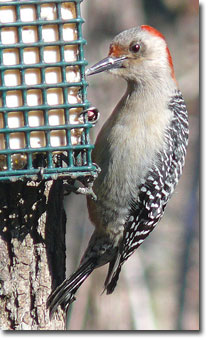Red-bellied Woodpecker
(Melanerpes carolinus)
Description & Range:
Despite their name, red-bellied woodpeckers do not have red bellies! These frequent bird feeder visitors actually were named for the unique pinkish tinge on their belly. Red-bellied woodpeckers have red cap on their heads and black and white barring along the back. On adult males, the red cap extends from the bill to the nape of the neck. Adult females, however, have a gray crown and a red patch on the nape of the neck and another above the bill. Juveniles have no red at all. Red-bellied woodpeckers also have white patches near the wingtips that are visible in flight.
Red-bellied woodpeckers are common throughout much of the eastern United States as well as throughout Maryland.
Red-bellied woodpecker female (left) by Dick Daniels,and male (right) by Roy W. Knight, Wikimedia Common
Habitat:
Red-bellied woodpeckers are frequently found in woodlands and forests. They particularly prefer old stands of oak and hickory (chock full of tasty acorns & nuts!) over younger stands of hardwoods and pines. Red-bellied woodpeckers can often be seen in backyards as well.
Diet:
The main food sources for red-bellied woodpeckers include insects, spiders, and other arthropods as well as acorns, nuts, seeds, and fruits. Red-bellied woodpeckers also will dine on suet and black oil sunflower seeds in backyard feeders. Occasionally, unlucky nestlings will also become a meal for red-bellied woodpeckers. Interestingly enough, in the winter, red-bellied woodpeckers often cache food for later consumption.
Reproduction:
Red-bellied woodpeckers mate in late win ter and begin nesting from March through early May. Generally, this species is monogamous. After mating, the pair will select and build their nest site together. Nests are built in cavities that take between 7-10 days to excavate. After the nest in complete, the female will lay 1 egg per day up to 4 days in a row. Both the male and the female will incubate the eggs over a 12 day period.
ter and begin nesting from March through early May. Generally, this species is monogamous. After mating, the pair will select and build their nest site together. Nests are built in cavities that take between 7-10 days to excavate. After the nest in complete, the female will lay 1 egg per day up to 4 days in a row. Both the male and the female will incubate the eggs over a 12 day period.
After hatching, both parents spend the next 3-4 weeks caring for their young until they fledge.
Behavior:
Like most other woodpeckers, red-bellied woodpeckers will hike up and down main tree branches in search of food. Woodpeckers often lean back on to their stiff tail feathers for support.
Sounds:
Most of the time, red-bellied woodpeckers make a shrill, rolling kwirr or churr call. Mating pairs also exchange a gruff, coughing cha cha cha sound or a throaty growl.
Did You Know?
Red-bellied woodpeckers have special cells on the end of their bills that are constantly being replaced due to the birds pounding on trees. In addition, red-bellied woodpeckers have a tongue almost 2 inches longer than its bill. The tip of their tongue is barbed, which along with sticky saliva, allows the bird to extract tasty prey from crevices in trees.
Photo on right: Red-bellied woodpecker
dining on suet by Ken Thomas, Wikimedia commons